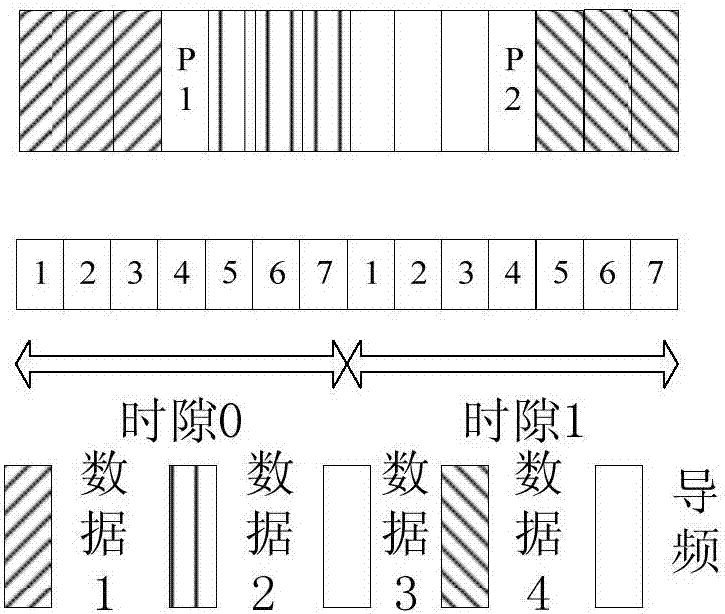Signal processing method and device
A signal processing and signal transmission technology, applied in the field of communication, can solve the problem of high peak-to-average ratio PAPR, achieve the effect of reducing PAPR, reducing terminal cost, and saving terminal energy consumption
- Summary
- Abstract
- Description
- Claims
- Application Information
AI Technical Summary
Problems solved by technology
Method used
Image
Examples
Embodiment 11
[0108] In this embodiment, the NB-IoT terminal sends uplink data through the NB-PUSCH. The terminal repeatedly sends a transport block at the OFDM symbol level, repeating R=3 times in total, and the modulation mode is QPSK. The modulation method of the pilot frequency is also QPSK. In this embodiment, Nsym=12, Ns=12, repeat 3 times to occupy Nsym*Ns*R=432 OFDM symbols in total. 432 OFDM symbols are divided into Nsym*Ns=144 groups. image 3 is a schematic illustration of OFDM symbols according to this embodiment Figure 1 ,Such as image 3 as shown, image 3 Only 14 OFDM symbols in two slots in one subframe are drawn, in which the pilot occupies the fourth symbol of the two slots, and the other symbols are data carrying information. Data 1 / 2 / 3 / 4 are 4 groups out of 144 groups, and there are 3 copies of OFDM symbols in each group. The data 1 / 3 adopts the QPSK constellation diagram Con1 specified in the Rel-12 version LTE protocol 36.211, and the data 2 / 4 adopts the constel...
Embodiment 12
[0111] In this embodiment, the NB-IoT terminal sends uplink data through the NB-PUSCH. The terminal repeatedly sends a transport block at the subframe level, for a total of R=3 times, and the modulation mode is QPSK. The modulation method of the pilot frequency is also QPSK. In this embodiment, Ns=12, repeating 3 times occupies a total of Ns*R=36 subframes. 36 OFDM symbols are divided into Ns groups. Each group has R subframes. Figure 4 is a schematic diagram of a subframe according to an embodiment of the present invention, Figure 4 There are 10 subframes in one radio frame. Such as Figure 4 As shown, the data 1 / 2 / 3 / 4 are 4 groups in Ns=12 groups, each subframe in each group has 3 copies, and 3 copies are a repeating unit. The same OFDM symbol position in each group of 3 subframes carries the same data and has the same constellation diagram version. While the constellation diagram version of the last OFDM symbol in subframe 3 and the first OFDM symbol in subframe 4 ...
Embodiment 13
[0114] In this embodiment, the NB-IoT terminal sends uplink data through the NB-PUSCH. Figure 5 is a schematic diagram of a TTI bearer according to an embodiment of the present invention, such as Figure 5 As shown, the terminal repeatedly sends a transport block at the TTI level for a total of R=3 times, and the modulation mode is QPSK. The modulation method of the pilot frequency is also QPSK. In this embodiment, OFDM symbols carrying the same data in three TTIs have the same constellation diagram version.
[0115] In this embodiment, when performing data processing on the sending side, the terminal generates modulation symbols of one copy of one transport block through coding and modulation, and these modulation symbols are mapped to Ns*Nsym OFDM symbols. The terminal makes data carrying information on adjacent OFDM symbols have different constellation diagram versions. Then the terminal maps the copy to Ns*Nsym*R OFDM symbols according to certain rules to obtain R copi...
PUM
 Login to View More
Login to View More Abstract
Description
Claims
Application Information
 Login to View More
Login to View More - R&D
- Intellectual Property
- Life Sciences
- Materials
- Tech Scout
- Unparalleled Data Quality
- Higher Quality Content
- 60% Fewer Hallucinations
Browse by: Latest US Patents, China's latest patents, Technical Efficacy Thesaurus, Application Domain, Technology Topic, Popular Technical Reports.
© 2025 PatSnap. All rights reserved.Legal|Privacy policy|Modern Slavery Act Transparency Statement|Sitemap|About US| Contact US: help@patsnap.com



